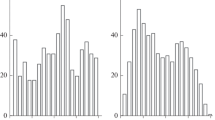Abstract
An attempt is made to determine the spatial location of the main source of short-period comet nuclei. Numerical calculations for the orbital evolution of Jupiter family comets, medium-period comets, and Centaurs are used to show that the orbits of small solar system bodies tend to evolve in the direction of increasing semimajor axes. This relates to bodies that can experience encounters with planets and whose orbital evolution is shaped by gravitational perturbations. It is concluded that there is good reason to search for the main source of the nuclei of Jupiter family comets at distances of 6 AU or less from the sun.
Similar content being viewed by others
References
S. K. Vsekhsvyatskii, “New Evidence for the Eruptive Origin of Comets and Meteorite Matter,” Astron. Zh. 44(3), 595–604 (1967).
A. F. Zausaev and A. A. Zausaev, “On the Origin of Short-Period Comets: The Evolution of Short-Period Comets,” Vestn. Sam. Gos. Tekhn. Univ., Ser. Fiz. 2(15), 145–150 (2007).
A. M. Kazantsev, “A Possible Mechanism for the Formation of Short-Period Comets,” Astron. Tsirk., No. 1215, 6–7 (1982).
A. M. Kazantsev, “A Simple Method for Calculating the Orbital Evolution of Near-Earth Asteroids,” Astron. Vestn. 36(1), 48–54 (2002).
A. M. Kazantsev, “Orbital Structure of the Kuiper Belt and Its Contribution in the Near-Earth Asteroid and Meteor Population,” Kin. Phys. Celest. Bodies 26(5), 249–256 (2010).
S. V. Orlov, “Evolution and Origin of Comets,” Astron. Zh. 16(1), 3–27 (1939).
L. M. Sherbaum and A. M. Kazantsev, “Relationship of Small Solar System Bodies,” Vestn. Kiev Univ. Astron., No. 27, 66–73 (1985).
E. M. Drobyshevskii, “The Eruptive Evolution of the Galilean Satellites-Implications for the Ancient Magnetic Field of Jupiter,” Moon Planets, No. 23, 483–491 (1980).
V. V. Emel’yanenko, “Structure and Dynamics of the Centaur Population: Constraints on the Origin of Short-Period Comets,” Earth, Moon, Planets 97(3–4), 341–351 (2005).
L. Kresak and M. Kresakova, “Secular Brightness Decrease of Periodic Comets,” Icarus 86(1), 82–92 (1990).
J. Svoren, “Secular Decrease in the Brightness of Short-Period Comets,” Contribs. Astron. Observ. Skalnate Pleso, No. 21, 15–49 (1991).
K. Volk and R. Malhotra, “The Scattered Disk as the Source of the Jupiter Family Comets,” Astrophys. J. 687(1), 714–725 (2008).
Author information
Authors and Affiliations
Additional information
Original Russian Text © A.M. Kazantsev, 2012, published in Kinematika i Fizika Nebesnykh Tel, 2012, Vol. 28, No. 6, pp. 45–57.
About this article
Cite this article
Kazantsev, A.M. Searching for the source of short-period comet nuclei: The direction of the spatial migration of comets. Kinemat. Phys. Celest. Bodies 28, 288–295 (2012). https://doi.org/10.3103/S0884591312060037
Received:
Published:
Issue Date:
DOI: https://doi.org/10.3103/S0884591312060037




